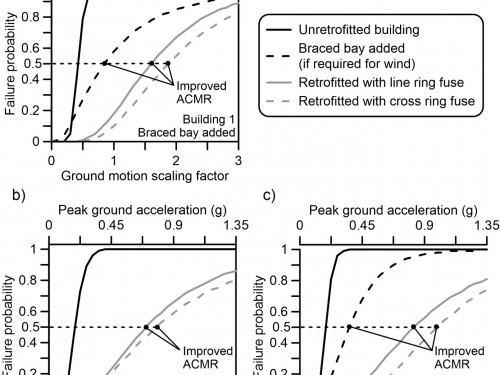Seismic Assessment and Design
Earthquake safety is a common challenge for historic and existing structures. Earthquakes are a movement more than a force. Newer buildings withstand ground movement by using strong and stiff materials. Historic buildings can often perform just as well if not better than new buildings by moving with the ground. Reinforcing an old building with new, strong and stiff materials can have disastrous consequences. This has been a painful lesson learned many times in Europe. Is your building lime mortar-based unreinforced masonry? Find out first to avoid costly repairs of damage caused by incompatible new materials.
Seismic assessment and design would be combined with a general Condition Assessment and Design. However, due to the unique nature of the issues they are described here separately.
Level 1 Seismic:
Level 1 Seismic Assessment is exclusively code-based and is the level of analysis offered by any conventional structural engineer. Design follows linear elastic analysis. This style of analysis has been created to allow the fastest and easiest design of structures. This evaluation is based on larger safety margins to simplify the models of seismic demand.
Although rapid and of lowest upfront engineering cost, design at this level is done without properly understanding the structure. It must be noted that one can run the risk of an intervention causing earlier damage to the structure. Although we are capable of code-based design, we generally advocate against it for historic buildings.
Level 2 Seismic:
Level 2 Seismic Assessment and Design uses commonly accepted resources available from American and Canadian Civil Engineering Societies, but which are not typically very familiar to the general structural engineer. The ASCE 41 – Seismic Evaluation and Retrofit of Existing Buildings is an example of such a resource. This and similar publications ensure that a greater understanding of the building is gained, that appropriate performance levels are assigned, and that real vulnerabilities are addressed. Designs are done in greater detail to avoid causing damage to the existing structural fabric.
Level 3 Seismic:
Level 3 Seismic Assessment and Design is customized to the building, its location, surroundings, and needs.
Further detailed assessment options include:
Considering actual building deformations and response of various building elements
Considering changing material properties during building motion
Considering actual ground motions for the location of the building as opposed to generalized ground motions
Evaluating advantages gained from ductility of materials
Evaluating exact material properties and responses
Looking at unique interventions that require advanced performance based design.
Advanced performance based design tools include research-grade finite element models, finite hinge zone models, and second order non-linear analysis software. It is important to understand that while these tools are important, they are not all the same, nor do they all produce the safe results for the same situation. At this level the focus is to identify and prioritize issues, then determine how best to address them.
